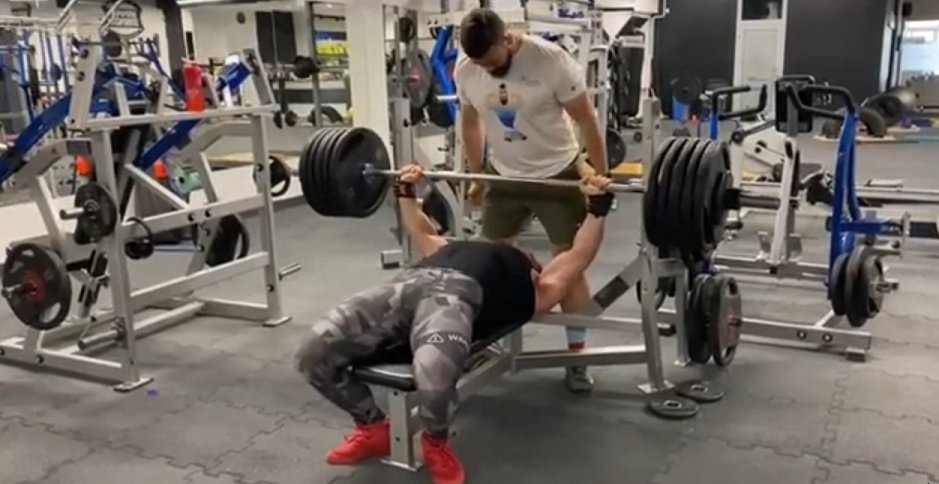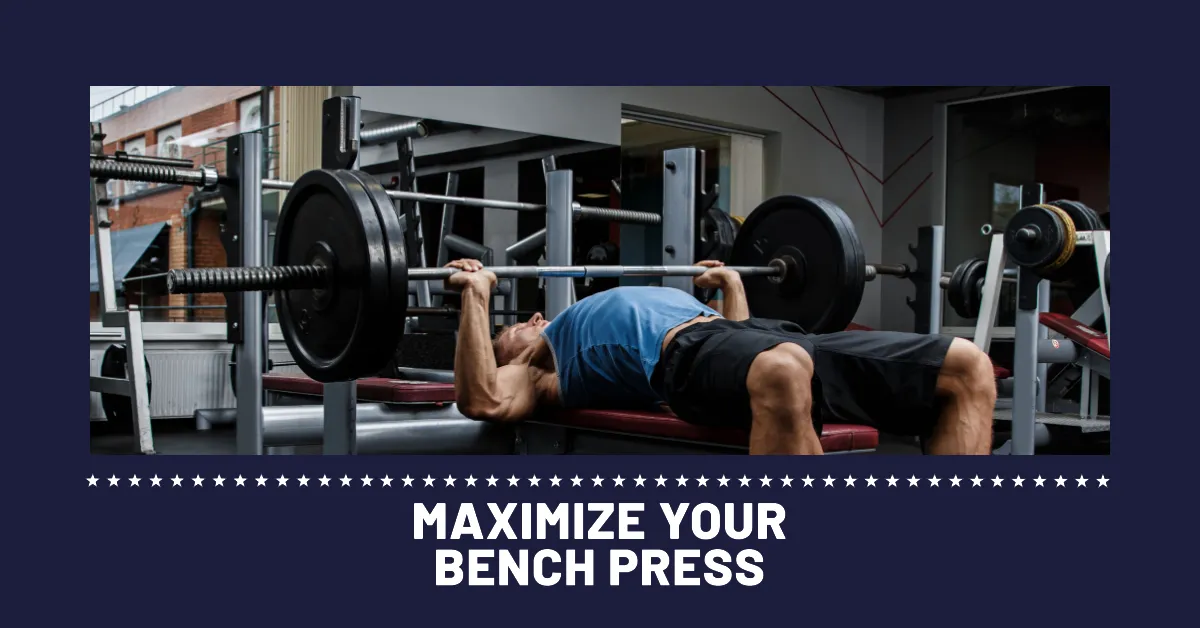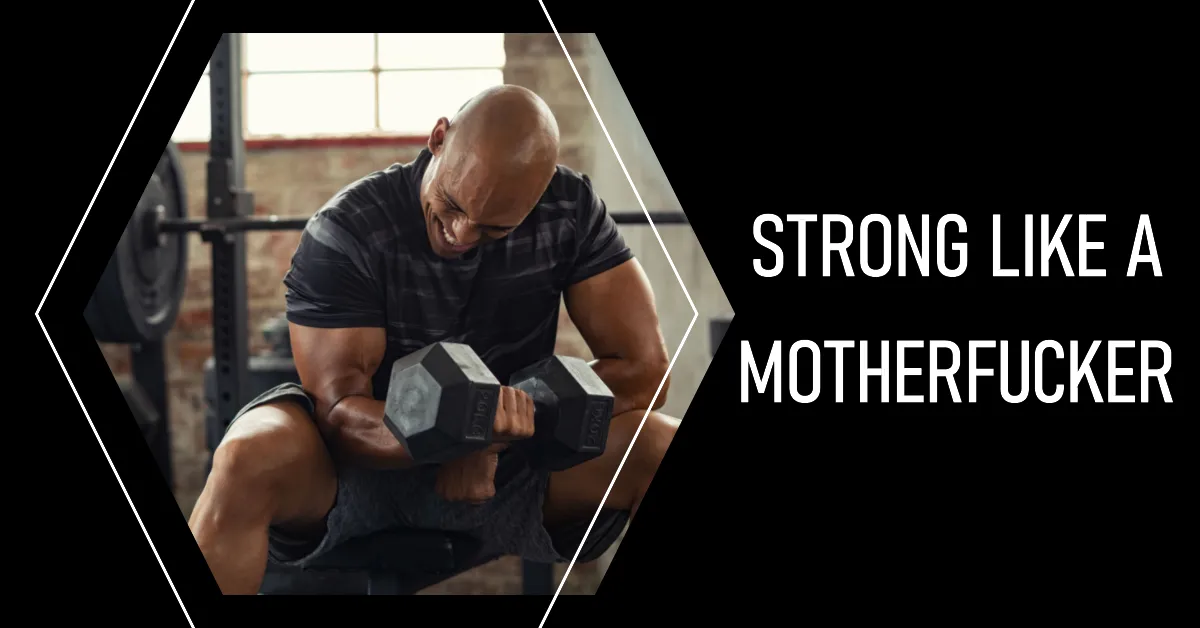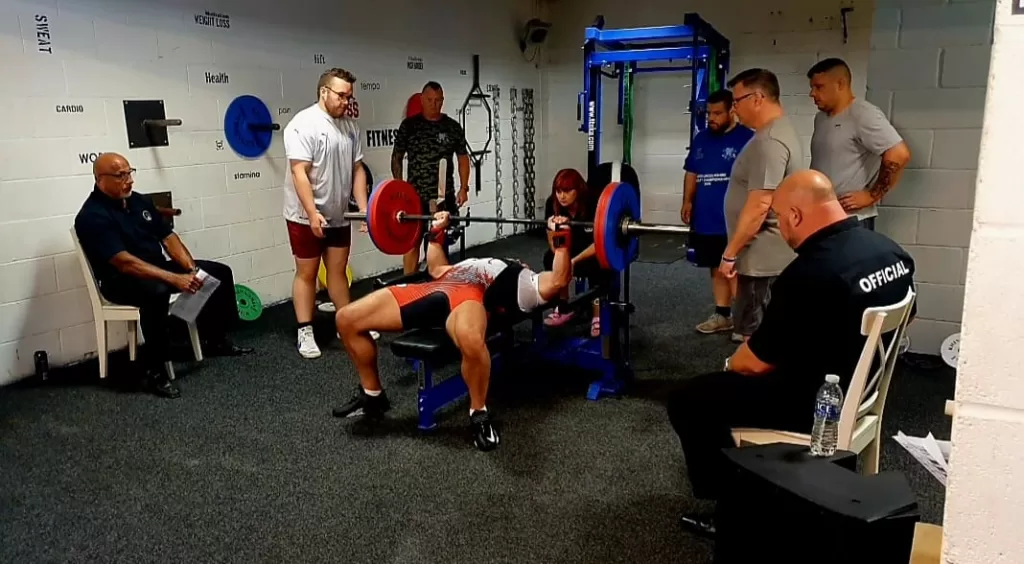Table of Contents
- 1 How To Bench Over 5 Plates Easy
- 2 Stay Strong
- 3 Max Out
- 4 Compensatory Acceleration Training
- 5 Train Your Triceps
- 6 Train Your Lats
- 7 Train Your Upper Back
- 8 The Process – A General Outline
- 9 Advanced Bench Press Exercises
- 9.1 Banded Dead Incline Close Grip Bench Press
- 9.2 Reverse Grip Bench Press
- 9.3 Close Grip Decline Bench Press
- 9.4 Football Bar Bench Press
- 9.5 Offset Loaded Bench Press
- 9.6 Log Press
- 9.7 Power Jerk
- 9.8 Banded Plyometric Pushups
- 9.9 Strongman Dumbbell Press
- 9.10 Isometric Bench Press Against Pins
- 9.11 Chained Bench Press with KBs attached
- 9.12 Dead Z-Press
- 10 Example Advanced Raw Bench Press Routine
- 11 Get Your Bench Manual Today!
How To Bench Over 5 Plates Easy
This guide is aimed at intermediate athletes who aspire to become professional bench pressers. Carry on reading if you already hit the 4-plate mark and want to take your bench press to the next level. However, if you are a beginner, I would recommend going through this article first.
Bench pressing is a complicated sport. Regardless of whether you do bench only or full power meets, you will need to follow a certain set of rules if you want to hit some big bench press numbers. The barbell bench press is a lift unlike any other. It’s much more precise than other lifts and can’t be forced solely by increasing the amount of drugs used or repeatedly maxing out. As it’s not a lower body lift, it reacts to different stimuli. It simply requires patience, maturity and an appropriate strategy. Otherwise, you’re not going to get far.
The method I am going to present you with is an optimised Westside Barbell approach that relies on similar principles that Westside Barbell and Louie Simmons (rest in peace) preach, however, it focuses on the RAW athletes. It means the form will differ, the strategy will differ and the execution will differ but the ideas will remain the same.
The original conjugate method is based upon 3 main principles: the maximum effort method (the strength day), the dynamic effort method (the speed day) and the repetition method effort (the hypertrophy day) and I do include all of those types of work but in a slightly different fashion. You will train for maximum strength, power and muscle hypertrophy simultaneously, covering all these 3 aspects as they are the fundaments of the big bench press.
Max effort bench press will help you build that tremendous strength. Dynamic effort bench press will help you develop monstrous explosive strength as it improves your RFD (Rate of Force Development). Repeated effort method will help you build the base strength and pack on some quality muscle mass. Barbell bench press exercises such as floor presses or dead bench presses will help you build that raw bench press strength and improve your weak links while dumbbell presses will improve your stability and help you stretch out your pecs and build more muscle. The conjugate method consists of all these techniques and that’s precisely why is it called the conjugate method.
To bench press big numbers, you will need to cover every aspect that can be potentially useful in your situation. Close grip bench press, specific muscle group training, max effort bench press, dynamic effort bench press aka speed day, dumbbell presses, accommodating resistance and explosive strength light band work – you will need them all.

Stay Strong
Building your strength will require you to focus on compound movements and get stronger in them. The isolation work is good, but in order to get the carryover you need, you will have to use exercise with more dynamic correspondence aka strength transfer. For instance, floor presses will always translate batter to the raw bench press than dumbbell presses. Accommodating resistance work such as the addition of a light band will transfer more than triceps extensions. Overhead press will transfer better than machine shoulder pressing. The rule is simple here: barbell exercise is the king.
Ok, so we’re crystal clear on this one but how heavy should you train?
If you want to become stronger, you have to stay strong in the first place. This means, your central nervous system has to stay ready and this is what big weights are for. Westside Barbell, Josh Bryant, Ryan Kennelly and many other strong lifters and coaches have one thing in common – they train with big weights so they can press event bigger weights in the future. Max effort day will help you get there but, please, bear in mind one thing. Maximum effort means you display maximum force production. Period. It doesn’t mean that you have to hit an RPE 10 lift each week.
Remember, weight training is an art.
Max Out
You will be maxing out on a regular basis in terms of force and power production but the reserve has to be kept. The idea is that it’s always better to not know how strong you are than to do know how weak you are in terms of strength training and I am pretty sure that every certified strength and conditioning coach will agree with me on this one.
The program includes a maximum effort day as it carries specific benefits with it:
- It keeps the central nervous system ready
- It stimulates the central nervous system to get stronger
- It allows you to familiarise yourself with heavy weights and competition-like conditions
If your goal is to bench press some big numbers, you will have to utilise the max effort day correctly and this means never hitting your true max in training.
Compensatory Acceleration Training
Although I’ve been experimenting with CAT training for a couple of years, Josh Bryant was the person who taught me how to do this for maximum gains. You can compensate for the lack of weight with acceleration and don’t worry, I don’t want you to use 60% of your max. I simply want you to lift a mere 5% reserve, which translates to pressing 190kg when you could actually hit 200kg on that day. The mechanism is the same as in the dynamic effort bench press – use submaximal weight, produce maximum force.
Despite it being a max effort bench press, I want you to utilise the “speed day principle” for the sake of energy conservation. Leave that 5% in reserve and you will recover better. Period.
It will still give you a great stimulus to develop your force production capabilities but will spare your central nervous system as the concentric phase will not last as long. If you really want a big bench press, you have to know when to back off. You will be able to max out eventually (at the end of the program) but before you do that, keep that 5% in reserve. Remember Hafthor Bjornson preparing for the 501kg deadlift? He didn’t miss a single lift during his preparatory period and I want you to do the same!
Train Your Triceps
For the raw bench press, the triceps is very important (similarly to the other agonist and support muscle groups. If you want to bench press Westside Barbell style, you should already know how important it is to have strong triceps. Close grip bench press, weighted dips, floor presses and other heavy barbell bench press variations will help you build that nasty piece of meat so you can move massive weights and join the conjugate club.
The triceps is an elbow extensor which means it helps you straighten your arm. It moves the weight up and makes up for 2/3 of your arm. Training your triceps muscles is very important not only in the equipped lifting but also in the raw bench press so do not neglect your triceps training!
The following triceps isolation exercises are useful when it comes to building a solid raw bench press:
- 1 + 1/4 Skullcrushers
- Cable Triceps Kickbacks
- Dynamic Rope Triceps Extensions
- Single Arm Supinated Triceps Extensions
- Seated DB French Press (overhead)
- Rolling Skullcrushers
- Dead Stop Barbell Skullcrushers (off the safety pins or from the floor)
- Overhead Rope Triceps Extension
Remember that those are just the isolation exercises that intend to increase your muscle mass. If you want to hit some real raw bench press numbers, you will also have to cover the big & nasty strength-building exercises (triceps extensions are good but they aren’t good enough by themselves!) but I will get to that later. Barbell exercise is the king. Always.
Train Your Lats
Latissimus dorsi muscles are antagonist muscles. They pull the humerus towards your torso, stabilise the bench and act as brakes when you press the weight up. However, if you want to press massive weights and join the conjugate club, you must also know that the lats can act as springs in the bench press. Simply lower the bar by contracting your lats and feel how your arms “fall into the socket”. This “socket” can be used as a trampoline. Using this manoeuvre will improve your explosive strength as the lats will initiate the movement and throw the weight up in the bottom portion of the lift.
Strong lats are important because they can hinder your bench press performance if they’re too weak. It’s called structural balance, a phenomenon popularised by Charles Poliquin a couple of decades ago. In a nutshell, it means that there are certain strength ratios that should be kept in a particular range if you want to optimise your results. If the lats are too weak, your CNS won’t allow for the maximum force production and you will simply stall until you strengthen the opposing muscles. If you ever trained using the original conjugate method, you know how important strong lats are during the dynamic effort bench press and the max effort bench press is no different. Speed day or not – the lats have to do their job!
The following exercises will help you strengthen your lats and build that massive raw bench press:
- Lat Pullaround
- Close Grip Lat Pulldown
- Single Arm Lat Pulldown
- Seal Rows aka Chest Supported Rows
- T-Bar Rows (including Prison T-Bar Rows)
- Seated Low Row
- Yates Rows
- Isometric Rows
- Banded Rows
Strong lats are important and this is no secret. Not just Westside Barbell but pretty much every strong bench presser will tell you that.
Train Your Upper Back
Dumbbell presses, accommodating resistance, triceps extensions, dynamic effort bench press are all good but it doesn’t mean jack shit if you ain’t got that upper back strength and mass.
Why?
Because the upper back muscles stabilise the shoulder girdle and they also oppose the pectorals. This means that if you want to keep the structural balance intact, you have to train your upper back. First of all, upper back muscles allow you to pin your scapulae into the bench and this builds stability. You will need both strong upper back muscles and big upper muscles and I will explain that in a second. Big does not always equal strong and vice versa. Strength is good but if you really want to optimise your raw bench press strength potential, you gotta treat your weight training holistically. Improving the musculature of your upper back muscles will help increase your stability on the bench because you will have that thick pad of muscles to lean on, it’s especially true for the dumbbell presses. The same goes for the overhead press. If your upper back is not tight, you will lose control and you will be leaking strength. Increasing the muscle mass will help you get tighter and your upper back will act as a shelf. Remember, you can’t shoot a cannon from a canoe!
These exercises will help you build gargantuan upper back muscles:
- Dumbell Reverse Flyes
- Single Arm Reverse Pec Deck
- Face Pulls
- Landmine Rear Delt Rows
- Horizontal Shrugs aka Chest Supported Scapular Rows
- Anti Shrugs aka Scapular Pullups
- Wide Grip Barbell Rows
- Banded Pull Apart
- Chest Supported Scarecrows
Strong upper back is the support for your bench regardless of whether you compete in the raw bench press or equipped bench press. Upper back muscles will help you stabilise your bench, express maximum power and simply get stronger!
The Process – A General Outline

A single block will consist of 4 subsequent training weeks. Speaking of the top set, there will be 3 weeks of heavy training and a single week of deload (deload to reload!) where you bench press using 50-60% of your estimated raw bench press one rep max. During the first 3 weeks of each training block, you will be using bench press variations that resemble the raw bench press in its execution closely and during the deload week, you will be doing the conventional version of the exercise. The variations will progress in a specific way and you will utilise a set of exercises where each week, the boundary between the variation of your choice and the conventional raw bench press will be progressively vanishing. Typically, you will go through 3 blocks of such a strategy and then either test your max straight away (after the deload) or run a conventional bench peaking cycle using the main exercise as your main protocol (the top set) depending on what works better for you. The idea behind this logic is that if you’ve been using the conventional bench press (same grip, same rep range, same technique) your body is already familiar with this stimulus. Therefore, you are to introduce a little exercise variation to hit your organism with a fresh stimulus hoping it will transfer to the competition lift, hence the variations have to be technically pretty close to the regular bench press and progress to a variation that resembles conventional bench the most in week 3.
After the max strength protocol aka max effort bench, you will move on to the speed presses (utilising the compensatory acceleration training principle) and to the bench press variations where the first variation will help you strengthen your weak link and the second variation will be a bench press derivative that will serve as GPP.
Unlike in the original Louie Simmons training program, I won’t divide the routine into max effort day, dynamic effort bench press and hypertrophy sessions. It is not the original Louie Simmons Westside Barbell weight training routine so things are slightly different. You will still need similar accessories & equipment but the way I categorise certain exercises isn’t the same. There will be 2 training days. A neurological day and a hypertrophy day. I know it might not look like the original conjugate method but the principles remain unchanged.
During the neurological day, you will focus on building strength (big weights) and power (light band speed work). During the hypertrophy day, you will focus on building muscle (dumbbell presses, machines, cables, etc.). You will spread the workouts apart evenly to ensure proper recovery, e.g.: Monday – neurological day, Wednesday/Thursday – hypertrophy day (and you can train your lower body on Friday for example). The idea is to potentiate the central nervous system with max effort bench press, dynamic effort bench press and variation exercises that transfer to the raw bench press the most.
In a nutshell, there is no separate speed day as your dynamic effort bench press is done on the same day as your max effort bench press. You simply raw bench press heavy, then do your speed work, then move on to the variations to work on your weak links and base strength. Finally, you wait a couple of days and blast out another bench workout but this time, you focus on the hypertrophy work.
The Neurological Day
The neurological day will combine the typical max effort bench press with the dynamic effort bench press. Think of it as the strength day and the speed day performed in one session. It will help you build fundamental qualities such as maximum strength (force output) and rate of force development (power output). Using a holistic approach is the key to the raw bench press as you need strength, power and muscle mass to bench big weights.
The structure of this day is as follows:
- Max effort bench press
- Dynamic effort bench press
- Variation #1 – weak link variation
- Variation #2 – raw bench press derivative
The top set will be your heavy effort work. Dynamic effort bench press can be treated as a speed day done straight after the top set. Variation #1 is to focus on your weak link and variation #2 is a bench press derivative that doesn’t resemble the conventional bench press too much but utilises similar muscle groups or a pressing movement pattern but executed in a different way. Examples are weighted dips and overhead presses.
Incorporate The Maximal Effort Method
Max effort bench press is performed with 1-3 rep range at RPE 9-9.5, that is with approximately 5% reserve. In a nutshell, you should be able to press a little bit more weight but you shouldn’t be leaving more than a single repetition in the tank. When it comes to the exercise choice, similarly to the Westside Barbell routine, the exercises will be rotated in a specific manner but in my system, they will start from the exercise variation that is the farthest from the conventional bench press in its execution and gradually progress to the variation that is the closest to the conventional raw bench in its execution.
Examples below:
Scenario 1: Manipulating Grip Width
- 3″ Closer Grip Bench Press
- 2″ Closer Grip Bench Press
- 1″ Closer Grip Bench Press
Scenario 2: Manipulating Band Tension
- Moderate Band Tension Bench Press
- Light Band Tension Bench Press
- Very Light Band Tension Bench Press
Scenario 3: Manipulating Time Under Tension
- 3s Paused Spoto Press
- 2s Paused Spoto Press
- 1s Paused Spoto Press
Scenario 4: Manipulating The Distance
- 3-Board Bench Press
- 2-Board Bench Press
- 1-Board Bench Press
Protip: You typically leave the weight unchanged during the progressive distance training routine and progress solely by increasing the range of motion.
Incorporate The Dynamic Effort Method
Our speed day substitution, i.e. CAT (Compensatory Acceleration Training) protocol is very simple: 3 sets, same reps as in the top set (1-3 reps), modify grip width each set, repeat for 2 rounds to hit 6 sets total.
Band tension: use light bands. How light is light? It depends on how much you lift. I am not going to give you any specific numbers because advanced lifters usually need unique strategies and the bench press is no different but I’ll give a hint. Band tension shouldn’t alter the bench press mechanics too much but you should be noticing that it’s slightly harder to press and forced to accelerate more than usual. The way I test it is I attach the bands to the empty bar and see if it feels like a slightly modified bench press or a completely different exercise. If the band tension is very prominent without the weight on the bar, it means the bands are probably too strong.
The idea is to prepare your central nervous system to press proficiently using various grips as it will familiarise you with close bench press variations. It will use a slightly different motor recruitment pattern but still similar enough to transfer to your competition bench. In a nutshell, by marginally varying the grip width in each set, you will prepare yourself better for working in a different environment. It will create new neuronal pathways and make you better in other bench variations and most importantly, will make those variations transfer more to the competition bench (more dynamic correspondence aka strength transfer).
How to correctly choose the intensity?
Well, that’s fairly simple, stick to the following guidelines:
- The last CAT set should be the easiest due to more activation rather than more fatigue
- Perceived intensity should progress from RPE 7 in week 1 to RPE 8-ish in week 3
- The weight should feel somewhat heavy but it should move meaningfully faster than your top set meaning your speed work should still be explosive
- When working solely with the competition lift, I usually use ~80% of the top set for the same amount of repetitions and 5-6 working sets when using straight weight. With bands on, it’s typically around 70%.
Use the following CAT aka speed bench protocol if you press with a relatively narrow to medium grip:
- 1-2″ Closer Grip Bench Press
- Competition Grip Bench Press
- 1-2″ Wider Grip Bench Press
Take a slightly longer rest and move on to the second round:
- 1-2″ Closer Grip Bench Press
- Competition Grip Bench Press
- 1-2″ Wider Grip Bench Press
Use the following CAT protocol if you bench press with a relatively wide grip:
- 2-4″ Closer Grip Bench
- 1-2″ Closer Grip Bench
- Competition Grip Bench
Longer rest, round 2
- 2-4″ Closer Grip Bench
- 1-2″ Closer Grip Bench
- Competition Grip Bench
And that’s it, your CAT aka speed bench protocol is done!
Incorporate The Variation Exercises
Both bench variation exercises should be performed for 5-6 repetitions. If you can do more than 6 reps, you should increase the weight. If you can’t complete 5 full repetitions under full control, the weight is too heavy. As you’re already an advanced lifter, a single set will suffice to elicit the neurological adaptations and make you stronger but I don’t mind if you go for up to 3 sets in the second variation (exercise #2) as it’s GPP work after all. In some cases, you might find that more work on the technique and stability is required or that 2-3 working sets simply do a better job when it comes to GPP and it might be more efficient to throw in an additional set or two.
Protip: Also notice that some exercises work better if performed in cluster sets or another, specific sequence, therefore, sometimes you might have to change the sets & reps range to get optimal results.
Variation #1: Weak Link Variation
This exercise should rely on a typical bench press motor pattern meaning it should resemble the bench press in its execution but the technique should be modified enough to hit your weak links. The aim of this exercise is to make you stronger at what you’re currently weak at. Examples of such exercises are close grip bench press, floor press, Spoto press, dead bench press, etc.
Variation #2: Raw Bench Press Derivative
This is a bench press derivative that utilises the same or similar (meaning anterior deltoids or clavicular pectoral fibres for example) muscle groups but differs in its execution from the conventional raw bench press. The aim of this exercise is to build a strength base. It is to be treated as GPP work. Example exercises are weighted dips, overhead press, strongman dumbbell press or even weighted renegade pushups if you feel they serve you well.
The Hypertrophy Day (Repeated Effort Method)
The hypertrophy day aims to elicit morphological adaptations, that is to help you build more muscle mass. This muscle mass, however, has to be functional simply meaning that if all you use are machines, the strength transfer won’t be as great and this is why I recommend starting with the dumbbell presses first and then moving on to the isolation exercises.
My recommendations are to hit the following muscle groups and movement patterns:
Pressing Muscles:
- DB Shoulder Press
- DB Incline Bench Press
- DB Bench Press
- Pectorals (Isolation)
- Triceps (Isolation)
Pulling Muscles:
- Horizontal Row
- Vertical Row
- Upper Back (Posterior Deltoids, Rhomboids and Transverse Trapezius)
- External and/or Internal Shoulder Rotators (Optional)
- Biceps
Typically, 3 sets of 6-10 reps (depending on the exercise) with 45-60s rest are enough. The goal is to accumulate as much work as possible in a relatively short time and take advantage of the workout density being a key driving factor for muscular hypertrophy.
Protip: If your triceps needs more work and it seems to recover without any issues, you can overload your triceps in both positions: the stretched position and the contracted position.
What does it mean?
Normally, when you use compound movements, the prime mover muscles usually do the most work when they are in their mid-position (between contracted and stretched position). This is due to the leverage. With the isolation exercises, the situation is a bit different as there are many options to choose from and you are working with just a single joint. This means that you can choose the appropriate exercise and successfully determine if the working muscle groups are producing the most force in the contracted or stretched position. Depending on which position needs the most strengthening (that is can the exercised muscle produce less force in the stretched or contracted position), you will gain more or less benefits from a certain exercise.
The triceps, however, consists of 1/3 of slow twitch fibres meaning it can typically stand a bit more volume than the pectorals so if you notice it recovers just fine and it feels somewhat undertrained, you can throw in another exercise that overloads the muscle in another position.
For example, if dumbbell 1 + 1/4 skullcrushers (stretched position) are your first triceps exercise, then you can add cable kickbacks (contracted position) as a second exercise to attack the muscle in a more holistic manner. Applying this strategy will maximise your muscular gains in the long run.
Advanced Bench Press Exercises

Advances lifters require advanced approaches and the exercise choice is no different. Everybody knows about the close grip bench, incline bench or weighted dips but not everyone is aware of the existence of other, more exotic exercises that can be a game changer for advanced athletes.
Here are a couple of not-so-obvious exercises that can help you reach your true potential:
Banded Dead Incline Close Grip Bench Press
Remember how some lifter press, suddenly stop pushing mid-way for a split sec and then sort of “turn their triceps on” and blast through with no further effort? This one will teach you how to coordinate your pecs and deltoids with the triceps and continue pushing until the end. Also, dead stop will make you produce a lot of force in the beginning, thus developing starting strength. Bands along with the close grip will help you activate the triceps more and force you to accelerate all the way through. They will also overload the negative phase (overspeed eccentrics).
Reverse Grip Bench Press
This is a great exercise for people who suffer from shoulder issues. It also places more focus on the upper pecs (clavicular fibres) and the medial head of the triceps which plays a major role during the lockout.
Close Grip Decline Bench Press
Great triceps and lockout builder. Decline bench hits the costal pec fibres and allows you to lift more weight due to the shortened range of motion while close grip does exactly the opposite and forces you to push longer. It’s pretty similar to close grip board pressing where you don’t have to lower the bar straight to the chest but in exchange, you are forced to push for longer which emphasizes the lockout phase. I use it to strengthen the mid and end phase of the bench press.
Football Bar Bench Press
The football bar places more emphasis on wrist stability as you have to actively oppose wrist deviation. The same goes for the shoulder joint (more stability demands) plus, it forces you to externally rotate the humerus thus, saving the glenohumeral joint.
Offset Loaded Bench Press
Not much weight difference here, you still want to press some decent weight. It will teach you how to properly activate the inactive side while benching by putting more stress on it. It can also serve as a great warmup tool before the main protocol.
Log Press
Strongmen do it for a reason! A wonderful mass builder for your shoulders and triceps. It also builds stability and works your core along with coordination by engaging the triple extension (simultaneous ankle, knee and hip joint extension) pattern.
Power Jerk
It differs from the log press and push press as it forces you to jump, change your feet positioning (spread them apart) and dip under the bar. I don’t need to mention that it develops the same qualities as the log press but what I do want to mention is that develops RFD (Rate of Force Development) by increasing the power output demands (if you’re too slow, you won’t finish the lift). This one is best done for singles with an appropriate rest (e.g. 5×1, 60-90s rest).
Banded Plyometric Pushups
Plyometric pushups improve starting strength, reactive strength, power output, coordination, strengthen your core and teach you how to correctly absorb force during the landing phase. Adding bands to the equation takes this exercise to a completely new dimension. Best performed in sets of triples (e.g. 3×3 or 5×3 with 60-90s rest).
Strongman Dumbbell Press
The benefits are similar to the log press but this one really builds that stability and coordination as it’s a single-armed exercise. It also allows you to overload the worked side as usually, you wouldn’t be able to press two such heavy dumbbells at once. Another benefit is the option to overload your muscles again by using a prolonged eccentric phase which can trigger more hypertrophy (more stress per motor unit).
Isometric Bench Press Against Pins
Set the pins at the sticking point height and produce maximum force for a set amount of time. Can be also utilised in a form of functional isometrics for reps where you load some weight on the bar, initiate the movement from your chest, accelerate and hit the pins as hard as you can. It literally obliterates sticking points and works very well in a combination with CAT-style bench press (in supersets).
Chained Bench Press with KBs attached
I actually learned this one from one of my clients as he was asking questions about various training methods and realised it’s a brilliant idea. Attach KBs to each side of the bar using chains. Measure the length appropriately so the KBs come into play at the sticking point height. Press the bar and as the chains rise, they will pull the kettlebells with them. The key is to measure everything correctly so both KBs kick in roughly evenly. You will be pressing the bar as usual and then it suddenly gets noticeably harder at one point (when the KBs kick in). It should feel slightly like an “upgraded” dead bench.
Protip: A similar effect can be achieved by clipping chain links together and measuring the length of the chain so several chain links get lifted off the floor at the sticking point height simultaneously. It will eliminate the instability effect caused by the hanging kettlebells and will allow you to express more force.
Dead Z-Press
Seated (on-the-floor) barbell shoulder press off the safety pins. Set the safety pins at shoulder height, load the bar, sit down in the rack and start pressing from a dead point. There is no stretch reflex that forces you to overcome the inertia from the start. Also, notice that you’re seated on the floor which increases stability demands and this means you have to brace yourself like a motherfucker to successfully press the weight up. Best performed in cluster sets.
Example Advanced Raw Bench Press Routine

Ok, so here is a typical routine, programmed for the athlete with a sticking point halfway through the movement. The starting phase is strong and the lockout is strong. The lifter’s one rep max is 200kg and his grip is pinky on the ring (a medium or middle grip).
Main Exercise (Top Set)
Chained Bench Press with KBs attached
Exercise execution: Attach KBs or DBs to the bar on each side using a chain or a rope so the additional weight kicks in at the sticking point height thus overloading the lift at this range of motion.
Weekly progression:
- Week 1: 6kg KBs per side
- Week 2: 4kg KBs per side
- Week 3: 2kg KBs per side
Reps: A single repetition
Compensatory Acceleration Training (Speed Sets)
Weight used: In this case, I would recommend loading around 140kg on the bar + light bands
Reps: A single repetition in each set
Grip widths:
- Grip #1: A thumb length from the knurling
- Grip #2: Pinky on the ring
- Grip #3: Middle finger on the ring
Sets: 6 sets total, grip #1, short rest, grip #2, short rest, grip #3, longer rest, grip #1, short rest, grip#2, short rest, grip #3, done!
Variation #1 (Weak Link)
Exercise: Functional Isometric Bench Press
Exercise execution: Get into the power rack, load 1-2 plates on the bar and set the safety pins at the sticking point height. Initiate the press explosively, hit the safety pins and push as hard as you can for 2 seconds. Put the bar back, rest 20 seconds and repeat for 5 total reps (or mini sets).
Sets and reps: 5 sets, 1 rep, 2-second push, 20s rest (or simply a cluster set of 5 with 20s rest between each rep)
Variation #2 (Bench Press Derivative)
Exercise: Z-Press with light bands and controlled eccentric
Exercise execution: Get tight, explode up and don’t stop pushing. Pause for a split second at the top and enter the negative phase. Lower down for 2 seconds and explode up as soon as you hit the bottom (no bottom pause).
Sets and reps: Start with approximately 8-10rm, 2 sets, 5 reps in the first set, 60 seconds rest, max reps in the second. Increase the weight when you’re able to hit 6 reps in the second set.
Hypertrophy Work
This session will be divided into 2 sections, the agonist section (pressing muscles) and the antagonist section (pulling muscles). Each section should take you no longer than 20-30 minutes and the whole session should be completed within 45-60 minutes. After completing 1 section, you are allowed to take a longer rest period (up to 5 minutes). There is no rocket science here, you are to quickly exhaust your muscles and pump the blood in.
Protip: If you feel like your back needs more work, start from the pulling muscles first.
The Agonist Section
Hit the pectorals, triceps and anterior deltoids. Your only goal is to make these muscles grow!
- 1 + 1/4 Kaz Press, 3 sets x 6 reps, 60s rest
- Seated DB Shoulder Press, neutral grip, partial reps, 3×8, 45s
- Incline DB Bench Press, 45dg pronated grip, 3×8, 45s
- Flat DB Bench Press, reverse grip, 3×8, 45s
- Pec Deck, 3×8, 45s
- Cable Triceps Kickbacks, 3×10, no rest between sides
The Antagonist Section
You are to hit your lats from the horizontal and vertical angles, move on to the upper back muscles, finish off with a biceps exercise and optionally engage the rotator cuff muscles directly.
- Barbell Seal Row 5×3, 45s (or Seated Low Row 3×8, 45s rest, if you want to see a more conventional approach)
- Single Arm Lat Pulldown, 3×8, no rest between sides
- Reverse Barbell Curls, 3×6, 60s
- Paused Banded Facepull, 3×8, 45s
And that’s it! No fucking around, get in the gym, do your shit and go back home. No more explanation is required!
Get Your Bench Manual Today!
This was an example training idea for advanced lifters who can’t get past certain bench numbers. If you liked this piece of work and want more content like that, click here to get your your advanced bench press guide.




